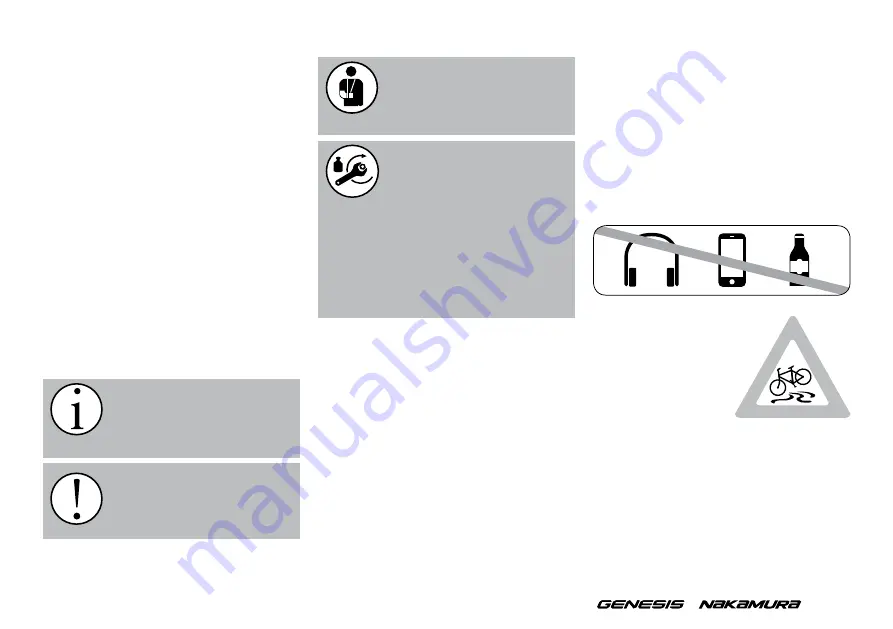
3
/
Check that the quick releases are fastened and
secured each time your bike has been left unat-
tended – even if it is for just a short time. Reg-
ularly make sure that all screws and parts are
securely fastened.
Be aware that all parts made of composite
materials (e.g. carbon fibre) usually require low
tightening torque values (see p. 40). Some typi
-
cal parts that are made of carbon fibre include
the handle bars, stem, seat post and saddle rails,
frame and fork, cranks. Ask your retailer for in-
structions on handling these kinds for materials.
These operating instructions have been written
with the assumption that the reader can already
ride a bicycle. These are not instructions on how
to ride a bike. Neither are they intended to inform
the reader on how to assemble or repair the bicycle
Please thoroughly read all of the warnings and
instructions in this operating manual before you
begin riding the bike. Always keep the operating
instructions close to your bicycle so that they are
available when you need them.
Before the first ride, be sure to read the
chapters “Before the First Ride” and “Before
Every Ride”!
If you give your bicycle to another person,
hand them the operating instructions, as well.
You will find four different kinds of notes in
these instructions – one gives you important
information about your new bicycle and its use.
Another tells you about the damages that could
be done to the components and environment.
The third warns about possible falls and serious
damage, including physical injury. When you see
these symbols, there is always a risk that the
danger described may occur. The field to which
the warning applies has a grey background.
Always be aware that riding a bicycle is danger-
ous. As a cyclist, you are particularly at risk. Al-
ways be aware that you are safer in a car than you
are on a bicycle. While on a bike, you do not have
an airbag or body shell. Nevertheless, you travel
faster than pedestrians while on the road. Pay par-
ticular attention to others on the road.
Never ride with headphones. Never talk on the
phone while riding. Never ride your bike if you are
not able to completely control it. Under no circum-
stance should you ride your bike if you took medi-
cine or are under the influence of alcohol or drugs.
•
Under wet and slip-
pery conditions, alter
your way of riding ac-
cordingly. In this case,
you should ride slower
and apply your brakes
earlier and more grad-
ually as the braking
distance becomes significantly longer.
•
Ride at an appropriate speed and in concord-
ance with the terrain and your riding capabilities.
•
Do not ride hands-free.
Safety information
Important:
This symbol provides
you with information about the
handling of the product or the part
being covered in the instruction
manual and should be paid close attention to.
Warning:
This symbol warns of
misuse which could result in dam-
aging the product or the environ-
ment.
Danger:
This symbol means your
life or heath could be put in dan-
ger if you don’t follow the instruc-
tions properly or ignore the legal
requirements.
Important bolted connection!
Here, you must tighten with an
exact torque. To find out the cor
-
rect tightening torque, you can ei-
ther look on the bike part itself or in the table
listing the tension values which is found on
page 40. A torque wrench must be used to
apply the exact tightening torque value. If you
don’t have a torque wrench, bring your bike to
a bike shop for repair. Parts that have been
installed incorrectly may fall off or break. This
may result in severe falls.
These notes are structured as follows:
Содержание Children's bike
Страница 62: ...58 Notes...
Страница 63: ...59...
Страница 64: ...60 Notes...
Страница 67: ...U7 Please read Make note of the bicycle identification and delivery document Notes...






















